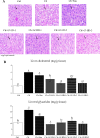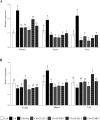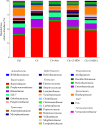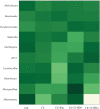Hypocholesterolemic Properties and Prebiotic Effects of Mexican Ganoderma lucidum in C57BL/6 Mice
- PMID: 27438015
- PMCID: PMC4954724
- DOI: 10.1371/journal.pone.0159631
Hypocholesterolemic Properties and Prebiotic Effects of Mexican Ganoderma lucidum in C57BL/6 Mice
Abstract
Edible and medicinal mushrooms contain bioactive compounds with promising effects on several cardiovascular risk biomarkers. However, strains of Ganoderma lucidum of Mexican origin have not yet been studied. Standardized extracts of G. lucidum (Gl) were given to C57BL/6 mice fed a high-cholesterol diet compared with the drug simvastatin. The effects of the extracts on serum biochemical parameters, liver lipid content, cholesterol metabolism, and the composition of gut microbiota were assessed. Acetylsalicylic acid (10 mM) added to the cultivation substrate modulated properties of Gl extracts obtained from mature basidiomata. Compared to the high-cholesterol diet group, the consumption of Gl extracts significantly reduced total serum cholesterol (by 19.2% to 27.1%), LDL-C (by 4.5% to 35.1%), triglyceride concentration (by 16.3% to 46.6%), hepatic cholesterol (by 28.7% to 52%) and hepatic triglycerides (by 43.8% to 56.6%). These effects were associated with a significant reduction in the expression of lipogenic genes (Hmgcr, Srebp1c, Fasn, and Acaca) and genes involved in reverse cholesterol transport (Abcg5 and Abcg8), as well as an increase in Ldlr gene expression in the liver. No significant changes were observed in the gene expression of Srebp2, Abca1 or Cyp7a1. In several cases, Gl-1 or Gl-2 extracts showed better effects on lipid metabolism than the drug simvastatin. A proposed mechanism of action for the reduction in cholesterol levels is mediated by α-glucans and β-glucans from Gl, which promoted decreased absorption of cholesterol in the gut, as well as greater excretion of fecal bile acids and cholesterol. The prebiotic effects of Gl-1 and Gl-2 extracts modulated the composition of gut microbiota and produced an increase in the Lactobacillaceae family and Lactobacillus genus level compared to the control group, high-cholesterol diet group and group supplemented with simvastatin. Mexican genetic resources of Gl represent a new source of bioactive compounds showing hypocholesterolemic properties and prebiotic effects.
Conflict of interest statement
Figures







Similar articles
-
Effects of Mexican Ganoderma lucidum extracts on liver, kidney, and the gut microbiota of Wistar rats: A repeated dose oral toxicity study.PLoS One. 2023 Apr 6;18(4):e0283605. doi: 10.1371/journal.pone.0283605. eCollection 2023. PLoS One. 2023. PMID: 37022999 Free PMC article.
-
Mexican Ganoderma Lucidum Extracts Decrease Lipogenesis Modulating Transcriptional Metabolic Networks and Gut Microbiota in C57BL/6 Mice Fed with a High-Cholesterol Diet.Nutrients. 2020 Dec 24;13(1):38. doi: 10.3390/nu13010038. Nutrients. 2020. PMID: 33374283 Free PMC article.
-
Effects of two Lactobacillus strains on lipid metabolism and intestinal microflora in rats fed a high-cholesterol diet.BMC Complement Altern Med. 2011 Jul 3;11:53. doi: 10.1186/1472-6882-11-53. BMC Complement Altern Med. 2011. PMID: 21722398 Free PMC article.
-
Molecular actions of hypocholesterolaemic compounds from edible mushrooms.Food Funct. 2018 Jan 24;9(1):53-69. doi: 10.1039/c7fo00835j. Food Funct. 2018. PMID: 29177335 Review.
-
Lactobacillus mediates the expression of NPC1L1, CYP7A1, and ABCG5 genes to regulate cholesterol.Food Sci Nutr. 2021 Sep 30;9(12):6882-6891. doi: 10.1002/fsn3.2600. eCollection 2021 Dec. Food Sci Nutr. 2021. PMID: 34925816 Free PMC article. Review.
Cited by
-
Adenosine-rich extract of Ganoderma lucidum: A safe and effective lipid-lowering substance.iScience. 2022 Sep 26;25(11):105214. doi: 10.1016/j.isci.2022.105214. eCollection 2022 Nov 18. iScience. 2022. PMID: 36281450 Free PMC article.
-
A Critical Review on Health Promoting Benefits of Edible Mushrooms through Gut Microbiota.Int J Mol Sci. 2017 Sep 8;18(9):1934. doi: 10.3390/ijms18091934. Int J Mol Sci. 2017. PMID: 28885559 Free PMC article. Review.
-
In vitro cholesterol lowering activity of Ganoderma australe mycelia based on mass spectrometry, synchrotron Fourier-transform infrared analysis and liver-spheroid bioactivity.Sci Rep. 2023 Aug 21;13(1):13619. doi: 10.1038/s41598-023-40861-8. Sci Rep. 2023. PMID: 37604902 Free PMC article.
-
Nutritional Profile and Health Benefits of Ganoderma lucidum "Lingzhi, Reishi, or Mannentake" as Functional Foods: Current Scenario and Future Perspectives.Foods. 2022 Apr 1;11(7):1030. doi: 10.3390/foods11071030. Foods. 2022. PMID: 35407117 Free PMC article. Review.
-
Effects of Mexican Ganoderma lucidum extracts on liver, kidney, and the gut microbiota of Wistar rats: A repeated dose oral toxicity study.PLoS One. 2023 Apr 6;18(4):e0283605. doi: 10.1371/journal.pone.0283605. eCollection 2023. PLoS One. 2023. PMID: 37022999 Free PMC article.
References
-
- National Cholesterol Education Program Expert Panel on Detection E, Treatment of High Blood Cholesterol in A. Third Report of the National Cholesterol Education Program (NCEP) Expert Panel on Detection, Evaluation, and Treatment of High Blood Cholesterol in Adults (Adult Treatment Panel III) final report. Circulation. 2002;106(25):3143–3421. - PubMed
MeSH terms
Substances
Grants and funding
LinkOut - more resources
Full Text Sources
Other Literature Sources
Medical
Miscellaneous

